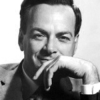Richard P. Feynman

Richard P. Feynman
Richard Phillips Feynmanwas an American theoretical physicist known for his work in the path integral formulation of quantum mechanics, the theory of quantum electrodynamics, and the physics of the superfluidity of supercooled liquid helium, as well as in particle physics for which he proposed the parton model. For his contributions to the development of quantum electrodynamics, Feynman, jointly with Julian Schwinger and Sin-Itiro Tomonaga, received the Nobel Prize in Physics in 1965...
NationalityAmerican
ProfessionPhysicist
Date of Birth11 May 1918
CountryUnited States of America
Phenomena complex-laws simple....Know what to leave out.
See that the imagination of nature is far, far greater than the imagination of man.
It has been discovered that all the world is made of the same atoms, that the stars are of the same stuff as ourselves. It then becomes a question of where our stuff came from. Not just where did life come from, or where did the earth come from, but where did the stuff of life and of the earth come from?
We're always, by the way, in fundamental physics, always trying to investigate those things in which we don't understand the conclusions. After we've checked them enough, we're okay.
I think equation guessing might be the best method to proceed to obtain the laws for the part of physics which is presently unknown. Yet, when I was much younger, I tried this equation guessing, and I have seen many students try this, but it is very easy to go off in wildly incorrect and impossible directions.
If you realize all the time what's kind of wonderful - that is, if we expand our experience into wilder and wilder regions of experience - every once in a while, we have these integrations when everything's pulled together into a unification, in which it turns out to be simpler than it looked before.
Today, all physicists know from studying Einstein and Bohr that sometimes an idea which looks completely paradoxical at first, if analyzed to completion in all detail and in experimental situations, may, in fact, not be paradoxical.
Things on a very small scale behave like nothing that you have any direct experience about. They do not behave like waves, they do not behave like particles, they do not behave like clouds, or billiard balls, or weights on springs, or like anything that you have ever seen.
The most remarkable discovery in all of astronomy is that the stars are made of atoms of the same kind as those on the earth.
Atoms are very special: they like certain particular partners, certain particular directions, and so on. It is the job of physics to analyze why each one wants what it wants.
The internal machinery of life, the chemistry of the parts, is something beautiful. And it turns out that all life is interconnected with all other life.
I don't understand what it's all about or what's worth what, but if the people in the Swedish Academy decide that x, y or z wins the Nobel Prize, then so be it.
Perhaps one day we will have machines that can cope with approximate task descriptions, but in the meantime, we have to be very prissy about how we tell computers to do things.
First figure out why you want the students to learn the subject and what you want them to know, and the method will result more or less by common sense.